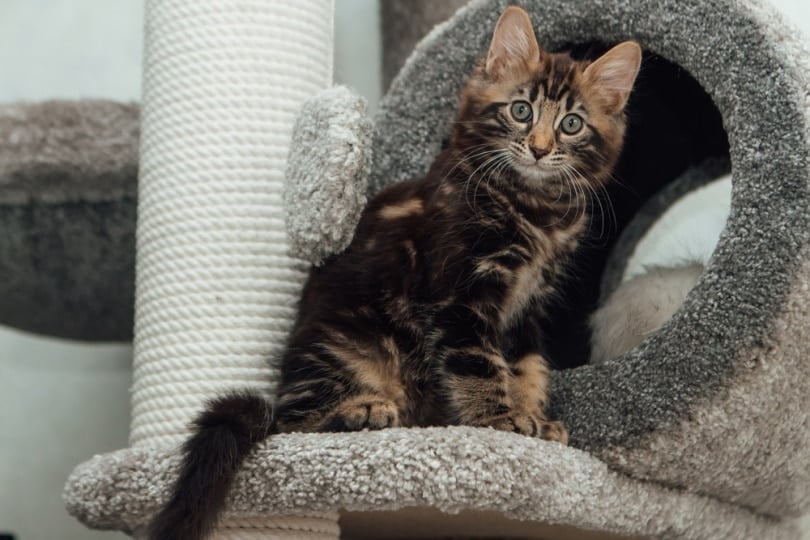Click to Skip Ahead
Good for you if you’ve just welcomed a new cat into your family! May you and your new buddy enjoy years of happiness, fun, and companionship together. But now that you’ve brought your friend home and have them all set up, it’s time to start thinking about a name for your pet.
If you’re considering an alcohol-themed name for your cat, we can help! We’ve compiled a list of 200 alcohol-inspired names for cats to help get you started.
How to Name Your Cat
Naming your cat doesn’t have to be daunting, and finding an option that reflects their personality can take time. You can name your cat based on their appearance or personality or because something about your new buddy reminds you of a cocktail or drink.
There are beer, wine, and liquor-themed names that run the gamut from hilarious to serious. There’s no right or wrong title; it’s all about finding a name that resonates with you and reflects something you love about your cat.

Cocktail-Inspired Cat Names
Cocktail-inspired names make great names for male and female cats. They’re full of potential if you’re looking for a name that reflects your cat’s personality.
- Brandy Alexander
- Bloody Mary
- Corkscrew
- Cosmopolitan
- Hurricane
- Bellini
- Spritzer
- Brooklyn
- MJ (Mint Julep)
- Lemon Drop
- Daiquiri
- Martini
- Hot Toddy
- Manhattan
- Mojito
- Margarita
- Caipirinha
- Pisco
- Vieux (Vieux Carré)
- Bitters
- Pina Colada
- Southside
- Bramble
- Oldie (Old Fashioned)
- Paloma
- Tonic
- Mudslide
- Rob (Rob Roy)
- Rusty (Rusty Nail)
- Bee (Bee’s Knees)
- Sazerac
- Boulevardier
- Negroni
- Cover (Clover Club)
- Mai Tai
- Stinger
- Highlander
- Mimosa
- Rocky
- Screwdriver

Wine-Inspired Cat Names
Who says you can’t name your cat after your favorite wine? Or better yet, go for a reference only you and your cat will understand, like how their personality reflects the qualities you most love in the wine that brings you joy.
- Champagne
- Sparkles
- Moscato
- Chardonnay
- Chablis
- Cava
- Merlot
- Pinot
- Beaujolais
- Vino
- Nero
- Riesling
- Magnum
- Refosco
- Dom
- Nebuchadnezzar
- Dom Perignon
- Cabernet
- Prosecco
- Sonoma
- Wine
- Tannin
- Shiraz
- Sonoma
- Rhone
- Chablis
- Chianti
- Gris
- Rose
- Sangria
- Noir
- Port
- Grigio
- Sherry
- Boone
- Cava
- Zinfandel
- Asti
- Margaux
- Mouton

Liquor-Inspired Cat Names
Let your creativity run wild with these names inspired by hard alcohol. This category is packed full of vibrant selections for outgoing pets, elegant options for reserved cats, and names that are just right for free-spirited kitties.
- Bourbon
- Moonshine
- Campari
- Cognac
- Glenlivet
- Jägermeister
- Jameson
- Bailey’s
- Juniper
- Sapphire
- Bailey
- JD (Jack Daniels)
- JB (Jim Beam)
- Jack
- Beam
- Stoli
- Brandy
- Amaretto
- SoCo
- Patrón
- Belvedere
- Captain (Captain Morgan)
- Fireball
- Absinthe
- Belvedere
- Gibson
- Bourbon
- Whisky
- CR (Crown Royal)
- Goose
- Hennessy
- Ketel
- Limoncello
- Schnaps
- Tequila
- Triple Sec
- Tanqueray
- Vesper
- Sambuca
- Vermouth

Beer-Inspired Cat Names
Beer-inspired names are ideal when your cat has a hoppy attitude. Whether you’re a serious craft beer lover or simply appreciate the beauty of a cold beer on a hot day, we’re sure you’ll find something to inspire you on this list.
- Hoppie
- Frosty
- Deschutes
- Amstel
- Dragonmead
- Barley
- Bud
- Guinness
- Miller
- Stella
- Allagash
- Stout
- Dubbel
- Moretti
- Porter
- Rasputin
- Bock
- Corona
- Lager
- Keystone
- Pabst
- Pilsner
- Sierra
- Victory
- Amber
- Kolsch
- Doppelbock
- Flanders
- Abbey
- Cascade
- Beamish
- Citra
- Banger
- Duvel
- Gose
- Molson
- Cristal
- Chouffe
- Chimay
- Grolsch

Fun Alcohol-Inspired Cat Names
Anyone who has lived with more than one cat understands that these incredible creatures have their own personalities, quirks, and tendencies. Celebrate your cat’s strong personality with one of these fun alcohol-inspired names for cats!
- Chaser
- Dash
- Buzz
- Cosmo
- Fizz
- Corky
- Bubbles
- Olive
- Spirit
- Spring
- Tipsy
- Twist
- Tot
- Zest
- Zombie
- Tallboy
- Toasty
- Rocks
- Pip
- Cork
- Bubbly
- Wine
- Winey
- Barefoot
- Corkscrew
- Wild Turkey
- Tornado
- Pint
- Sticky Boots
- Vino
- Rogue
- Mint
- Brewster
- Stormy
- Royale
- Swizzle
- Sparkles
- Punchy
- Monte (Monte Carlo Beer)
- Balthazar
Conclusion
If you’ve just adopted a new feline companion, congratulations! Now comes the hard part of finding just the right name for your cat. There are several alcohol-themed names to choose from for kitties, from the whimsical to the tough! Selecting your cat’s name can take a bit of time, and there’s no rush. Relax and enjoy getting to know your new family member!
Read Also:
- 125 Exotic and Wild Cat Names: Great Ideas for Your Cat
- 100+ Popular Cat Names: Top Ranked Cat Names
Featured Image Credit: Sarah Fields Photography, Shutterstock











